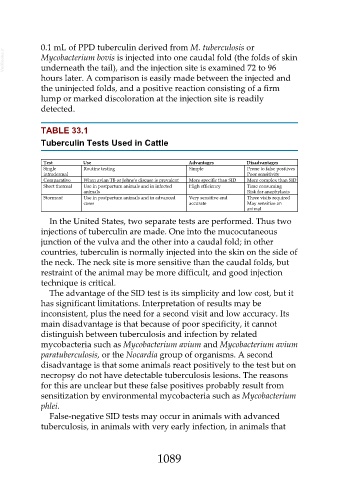Page 1089 - Veterinary Immunology, 10th Edition
P. 1089
0.1 mL of PPD tuberculin derived from M. tuberculosis or
VetBooks.ir Mycobacterium bovis is injected into one caudal fold (the folds of skin
underneath the tail), and the injection site is examined 72 to 96
hours later. A comparison is easily made between the injected and
the uninjected folds, and a positive reaction consisting of a firm
lump or marked discoloration at the injection site is readily
detected.
TABLE 33.1
Tuberculin Tests Used in Cattle
Test Use Advantages Disadvantages
Single Routine testing Simple Prone to false positives
intradermal Poor sensitivity
Comparative When avian TB or Johne's disease is prevalent More specific than SID More complex than SID
Short thermal Use in postpartum animals and in infected High efficiency Time consuming
animals Risk for anaphylaxis
Stormont Use in postpartum animals and in advanced Very sensitive and Three visits required
cases accurate May sensitize an
animal
In the United States, two separate tests are performed. Thus two
injections of tuberculin are made. One into the mucocutaneous
junction of the vulva and the other into a caudal fold; in other
countries, tuberculin is normally injected into the skin on the side of
the neck. The neck site is more sensitive than the caudal folds, but
restraint of the animal may be more difficult, and good injection
technique is critical.
The advantage of the SID test is its simplicity and low cost, but it
has significant limitations. Interpretation of results may be
inconsistent, plus the need for a second visit and low accuracy. Its
main disadvantage is that because of poor specificity, it cannot
distinguish between tuberculosis and infection by related
mycobacteria such as Mycobacterium avium and Mycobacterium avium
paratuberculosis, or the Nocardia group of organisms. A second
disadvantage is that some animals react positively to the test but on
necropsy do not have detectable tuberculosis lesions. The reasons
for this are unclear but these false positives probably result from
sensitization by environmental mycobacteria such as Mycobacterium
phlei.
False-negative SID tests may occur in animals with advanced
tuberculosis, in animals with very early infection, in animals that
1089

